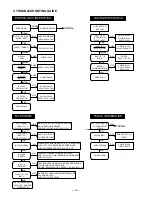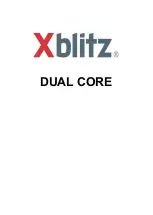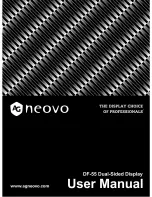
− 5 −
1-2. CA2 CIRCUIT DESCRIPTION
1. Circuit Description
1-1. Digital clamp
The optical black section of the CCD extracts averaged val-
ues from the subsequent data to make the black level of the
CCD output data uniform for each line. The optical black sec-
tion of the CCD averaged value for each line is taken as the
sum of the value for the previous line multiplied by the coeffi-
cient k and the value for the current line multiplied by the
coefficient 1-k.
1-2. Signal processor
1.
γ
correction circuit
This circuit performs (gamma) correction in order to maintain
a linear relationship between the light input to the camera
and the light output from the picture screen.
2. Color generation circuit
This circuit converts the CCD data into RGB signals.
3. Matrix circuit
This circuit generates the Y signals, R-Y signals and B-Y sig-
nals from the RGB signals.
4. Horizontal and vertical aperture circuit
This circuit is used gemerate the aperture signal.
1-3. AE/AWB and AF computing circuit
The AE/AWB carries out computation based on a 64-seg-
ment screen, and the AF carries out computations based on
a 6-segment screen.
1-4. SDRAM controller
This circuit outputs address, RAS, CAS and AS data for con-
trolling the SDRAM. It also refreshes the SDRAM.
1-5. Communication control
1. UART
The RS-232C can be sued for both synchronous and asyn-
chronous transmission.
2. SIO
This is the interface for the 4-bit microprocessor.
3. PIO/PWM/SIO for LCD
8-bit parallel input and output makes it possible to switch
between individual input/output and PWM input/output.
1-6. TG/SG
Timing generated for 1.3 million/1.09 million pixel CCD con-
trol.
1-7. Digital encorder
It generates chroma signal from color difference signal.
2. Outline of Operation
When the shutter opens, the reset signals (ASIC and CPU)
and the serial signals (“take a picture” commands) from the
4-bit microprocessor are input and operation starts. When
the TG/SG drives the CCD, picture data passes through the
A/D and CDS, and is then input to the ASIC as 10-bit data.
The AF, AE, AWB, shutter, and AGC value are computed from
this data, and three exposures are made to obtain the opti-
mum picture. The data which has already been stored in the
SDRAM is read by the CPU and color generation is carried
out. Each pixel is interpolated from the surrounding data as
being either Ye, Cy, Mg and Gr primary color data to produce
R, G and B data. At this time, correction of the lens distortion
which is a characteristic of wide-angle lenses is carried out.
After AWB and
γ
processing are carried out, a matrix is gen-
erated and aperture correction is carried out, and the data is
then compressed by the JPEG method by (JPEG) and is then
written to card memory (smart media).
When the data is to be output to an external device, it is taken
data from the memory and output via the UART. When played
back on the LCD and monitor, data is transferred from memery
to the SDRAM, and is displayed over the SDRAM display
area.
3. LCD Block
During monitoring, YUV conversion is carried out for the 10-
bit CCD data which is input from the A/D conversion block to
the ASIC and is then transferred to the DRAM so that the
CCD data can be displayed on the LCD.
The data which has accumulated in the DRAM is passed
through the NTSC encoder , and after D/A conversion is car-
ried out to change the data into a Y/C signal, the data is sent
to the LCD panel and displayed.
If the shutter button is pressed in this condition, the 10-bit
data which is output from the A/D conversion block of the
CCD is sent to the DRAM (DMA transfer), and after proces-
sor, it is displayed on the LCD as a freeze-frame image.
During playback, the JPEG image data which has accumu-
lated in the flash memory is converted to YUV signals, and
then in the same way as during monitoring, it is passed through
the NTSC endoder, and after D/A conversion is carried out to
change the data into a Y/C signal, the data is sent to the LCD
panel and displayed.
The two analog signal (Y/C signals) from the ASIC are con-
verted into RGB signals by the LCD driver, and these RGB
signals and control signal which output from the LCD driver
are used to drive the LCD panel. The RGB signals are 1H
transposed so that no DC component is present in the LCD
element, and the two horizontal shift register clocks drive the
horizontal shift registers inside the LCD panel so that the 1H
transposed RGB signals are applied to the LCD panel. Be-
cause the LCD closes more as the difference in potential be-
tween the COM (common polar voltage: fixed at DC) and the
R, G and B signals becomes greater, the display becomes
darker; if the difference in potential is smaller, the element
opens and the LCD become brighter.
Содержание VPC-Z380
Страница 13: ... 13 2 5 BOARD LOCATION SY1 board PW1 board CA1 board SY2 board CA2 board ...
Страница 29: ...Sep 99 4 760 NS Printed in Japan SANYO Electric Co Ltd Osaka Japan ...
Страница 30: ......






































